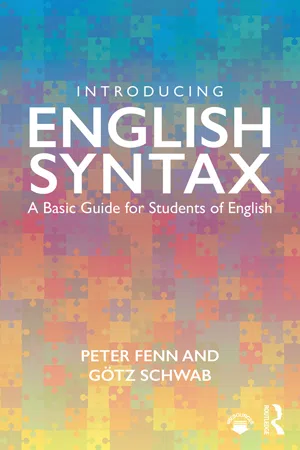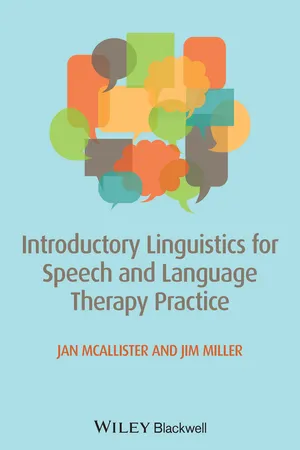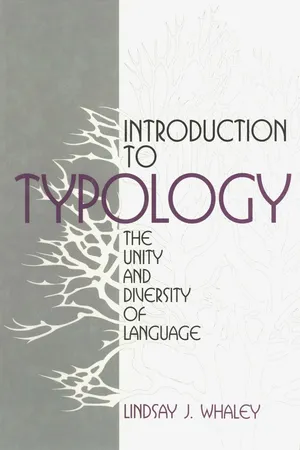Languages & Linguistics
Types of Phrases
In linguistics, phrases are groups of words that function as a single unit within a sentence. There are several types of phrases, including noun phrases, verb phrases, prepositional phrases, and adjective phrases. Each type serves a specific grammatical function and can contain various elements such as nouns, verbs, adjectives, adverbs, and prepositions.
Written by Perlego with AI-assistance
Related key terms
Related key terms
1 of 4
Related key terms
1 of 3
5 Key excerpts on "Types of Phrases"
- eBook - ePub
- Gerald Nelson(Author)
- 2019(Publication Date)
- Routledge(Publisher)
Phrases3.1 What is a phrase?In general use, the term ‘phrase’ usually refers to more than one word, as in ‘once upon a time’ or ‘curiosity killed the cat’. In grammar, however, the term ‘phrase’ also includes single words. This is shown in the Grammatical Hierarchy (Figure 1.1 , p. 2). The Hierarchy tells us:Phrasesconsist of one or moreWordsThis means that even one word, in grammar, is considered to be a phrase. The reason for this is quite straightforward. It is because one word, like books , can be expanded to form larger constituents:books expensive books expensive books about gardeningWhen we discussed word classes in the previous chapter, we referred to books as a noun, but at the phrase level it is a noun phrase. Similarly, expensive books and expensive books about gardening are noun phrases. Notice that they can all occupy the same position in a sentence, and they can all be replaced by the pronoun them :Amy bought books. expensive books. expensive books about gardening. them. When we looked at pronouns in section 2.3 , we said that they can replace nouns, but more correctly, they replace noun phrases.There are five major phrase types, as shown in Table 3.1 :Table 3.1 The five phrase typesPhrase type Examples 1. Noun phrase (NP) books, expensive books, expensive books about gardeningMain word: books 2. Adjective phrase (AdjP) proud, very proud, very proud of her sonMain word: proud 3. Adverb phrase (AdvP) recently, very recently, very recently indeedMain word: recently 4. Prepositional phrase (PP) on time, exactly on timeMain word: on 5. Verb phrase (VP) was stolen, has been stolenMain word: stolen 3.2 The basic structure of phrasesThe first four phrase types shown in Table 3.1 all have the same potential three-part structure:Figure 3.1The fifth phrase type, the verb phrase (VP), is quite different from the other four in terms of structure. We will look at verb phrases in 3.7. - eBook - ePub
Introducing English Syntax
A Basic Guide for Students of English
- Peter Fenn, Götz Schwab(Authors)
- 2017(Publication Date)
- Routledge(Publisher)
regularly , then, represent phrases (a verb phrase and an adverb phrase respectively), i.e. phrases with only one constituent. And by the same token the single-word constituents of (1), (2) and (4) can now be described, more accurately in a syntactic sense, as phrases:p.10 1.3 What word-classes are there, and what are their characteristic features? If you look a word up in a dictionary, you will find that its word-class (part of speech) is given before the meaning. For instance:This underlines a point made above: that word-class is a permanent feature of a particular word, i.e. part of its individual character.We generally distinguish between the following main word-classes: nouns, pronouns, verbs, adverbs, adjectives, prepositions, conjunctions, determiners.We will now point to basic features that identify each word-class, using the three different perspectives of semantics, morphology and syntax. The functional aspect of syntax will not be discussed here, however, as functions are not introduced until the next chapter. Under the ‘syntax’ heading we will confine ourselves for the moment to other kinds of relationship between words.1.3.1 Nouns• Semantics:Nouns denote entities , i.e. living things (person , woman , plant , animal ), objects (table , road , car ), other physical phenomena (weight , distance , electricity , rain , wind ), and abstractions like concepts and ideas (wish , religion , memory , economics , friendship ). Names such as Peter , London , Christianity , Communism are called proper nouns - Jan McAllister, James E. Miller(Authors)
- 2013(Publication Date)
- Wiley-Blackwell(Publisher)
As a result, many of the clinical resources that SLTs use target syntax. The Psycholinguistic Assessment of Language Processing in Aphasia (PALPA) has several sections that focus on Sentence Processing and that examine the use of quite sophisticated sentence structures. SLTs who work with children will routinely use assessments such as the South Tyneside Assessment of Syntactic Structures (STASS) and the Dorset Assessment of Syntactic Structures (DASS), which are concerned with syntax and morphology, or the Clinical Evaluation of Language Fundamentals (CELF), which has Sentence Structure sub-tests in the versions for preschoolers and for older children. The STASS, the DASS and the LARSP (the Language Assessment, Remediation and Screening Program, on which the STASS and DASS are based) make explicit reference to the Phrase and Clause levels of description that will be the focus of this chapter.7.2 Learning objectives After reading this chapter and doing the exercises, you should be able to:- List some tests for determining whether a group of words is a phrase;
- Explain what is meant by the head of a phrase;
- Recognise and give examples of the following kinds of phrases:
- Noun Phrase
- Prepositional Phrase
- Adjective Phrase
- Adverb Phrase
- Verb Phrase;
- Define the concept of the clause as it is used in this chapter;
- Identify the following elements of the clause in some simple examples:
- Subject
- Verb
- Direct object
- Indirect object
- Complement
- Adverbial.
In Chapter 2, we drew a distinction between lexemes, which we could think of as the heading on an entry in the mental lexicon (e.g. SAY) and the grammatical word forms that are associated with it (e.g. say, says, saying, said- eBook - ePub
Corpus Linguistics for Vocabulary
A Guide for Research
- Paweł Szudarski(Author)
- 2017(Publication Date)
- Routledge(Publisher)
The open-choice principle refers to language users’ unrestricted choices, in which words are treated as single elements selected item-by-item to construct grammatically correct sentences (the slot-and-filler approach). The idiom principle, in contrast, stipulates that instead of constructing new sentences in a piecemeal manner, speakers and writers make extensive use of ready-made phrases or chunks, which consist of specific patterns and recurring lexico-grammatical elements. This brings us to the concept of lexico-grammar, which occupies a central position within corpus-based investigations of phraseology. As stated by Römer (2009: 160), corpus research on the idiom principle has revealed “the inseparability of lexis and grammar”, two aspects of language traditionally seen as separate levels of linguistic description. However, once we adopt a corpus perspective, this dichotomy is no longer tenable because lexico-grammar, a notion which emphasizes the pervasiveness of various kinds of phraseological units, becomes the focal point of analysis. The term was first coined by Halliday (1961) and it came into widespread use after the advent of large corpora, which have enabled automatic analyses of the occurrence of various kinds of lexico-grammatical sequences. The aim of the following sections is to present examples of such sequences and explain how they can be studied by means of corpus techniques. 5.4 Types of multiword units Having underlined the importance of phraseology in the previous section, we can now turn our attention to different types of multiword units. Using Sinclair’s (2004) model of phraseology, we will introduce the notions of collocation, colligation, semantic preference and semantic prosody as examples of how words tend to cluster with one another and form extended units of meaning - eBook - ePub
Introduction to Typology
The Unity and Diversity of Language
- Lindsay J. Whaley(Author)
- 1996(Publication Date)
- SAGE Publications, Inc(Publisher)
What is amazing about this particular example is that the use of suffixes to mark definiteness is not a trait of any of the language branches from which the languages come. Indeed, the origin of this formal trait is still somewhat of a mystery. What is crucial for present purposes, however, is that, from a genetic standpoint, none of these languages are expected to employ this morphological strategy. The fact that they share it can only be due to their geographical connection.This type of linguistic similarity between languages of different genetic stock is particularly common in speech communities where two or more languages coexist and there is a high degree of multilingualism; in such cases, it is well attested that parts of the grammar of one language can be adopted by another (see Myers-Scotton 1993).Therefore, although typological classification is a different sort of procedure than are genetic, geographic, and demographic classifications, it must be recognized that the typological characteristics of languages can be greatly influenced by these other factors.One final point about typology’s focus on the formal features of language requires comment. “Formal features” are the chunks of information that one finds in language, its phrases, sentences, and so on. These features are, of course, used to convey meaning. Consequently, typologists have always been concerned with semantic categories, such as “tense,” “agent,” or “gender,” and how these categories are manifested by the formal units of language. Therefore, the emphasis on formal features in the definition of typology given previously should not be taken to exclude semantic considerations.2.0. Summary
Breaking down the definition of typology into three parts has helped to clarify what is involved in exploring language from a typological perspective. Before we move on to the next chapters, one reminder is needed: Typology is more than mere taxonomy (listing)—what we find in a typological analysis should have implications for our question, “What is language?” To get to the heart of this question requires one to seek explanations for typological patterns. It is not enough to say “labiodental stops do not exist” or “relative clauses typically follow the noun which they modify.” We must seek a plausible explanation for why these things are so. This type of “why” question, however, often forces us to go beyond grammar itself for an answer. We commonly must enter other “extragrammatical” domains: discourse, pragmatics, physiology, cognition, speech processing, language contact, social influences, and so on.
Index pages curate the most relevant extracts from our library of academic textbooks. They’ve been created using an in-house natural language model (NLM), each adding context and meaning to key research topics.
Explore more topic indexes
Explore more topic indexes
1 of 6
Explore more topic indexes
1 of 4




